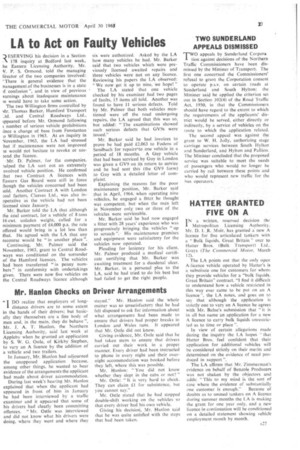LA to Act on Faulty Vehicles
Page 29

If you've noticed an error in this article please click here to report it so we can fix it.
ESERVING his decision in a Section 178 inquiry at Bedford last week, he Eastern Licensing Authority, Mr. V. P. S. Ormond, told the managing lirector of the two companies involved: There is general evidence that the nanagement.of the businesses is in a state if confusion ", and in view of previous varnings about inadequate maintenance le would have to take some action.
The two Willington firms controlled by vlr. Thomas Barker, Ilamford Transport ..td. and Central Roadways Ltd., tppeared before Mr. Ormond following t number of serious vehicle prohibitions :ince a change of base from Fenstanton o Willington in 1963. At an inquiry in• November, 1963, the LA had stressed hat if maintenance were not improved le would not hesitate to revoke or susoend the licence.
Mr. D. Palmer, for the companies, lelped the LA sort out an extremely nvolved vehicle position. He confirmed :hat two Contract A licences with Eastern Gas Board were still in force :hough the vehicles concerned had been ;old. Another Contract A with London coal factors, Cleeves Ltd., was also in-' operative ai the• vehicle had not been licensed since January. -' Mr. Barker told the LA that although the coal contract, for a vehicle of 8 tons 16 cwt. unladen weight, called for a minimum payment of 14,000 p.a. the rate offered would bring in a lot less than that. He agreed with the LA that any recourse would be in another place ".
Continuing, Mr. Palmer said the November, 1963, grant to Central Roadways was conditional on the surrender of the Hamford licences. The vehicles had been transferred "in penny numbers " in conformity with undertakings given. There were now five vehicles on the Central Roadways licence although six were authorized. Asked by the LA how many vehicles he had, Mr. Barker said that two vehicles which were previously licensed awaited repairs and three vehicles were not on any licence. Reviewing his papers the LA observed: We now get it up to nine, We hope!"
The LA stated that one vehicle checked by his examiner had two pages of faults, 15 items all told. Another was found to have 11 serious defects. Told by Mr. Palmer that both vehicles mentioned were off the road undergoing repairs, the LA agreed that this was so, but added: "The examinations showed such serious defects that GV9s were issued."
Mr. Barker said he had invoices to prove he had paid 12,063 to Fodens of Sandbach for repairs*to one vehicle in a period of 18 months. A Guy vehicle that had been serviced by Guy in London was given a GV9 on its return to service and he had sent this (the 0V9 form) to Guy with a detailed letter of complaint.
Explaining the reasons for the poor maintenance position, Mr. Barker said that in April, 1964,. when operating nine vehicles, he engaged a fitter he thought was competent, but when the man left in November only two or three of the vehicles were serviceable.
Mr. Barker said he had now engaged a fitter with 28 years' experience who was progressively bringing the vehicles "up to scratch ".• His maintenance premises and equipment were satisfactory for the vehicles now operated.
Pleading for leniency for his client, Mr. Palmer produced a medical certificate certifying that Mr. Barker was awaiting treatment for a duodenal ulcer. Mr, Barker, in a personal plea to the LA, said he had tried to do his best but had failed to get the right people.




































































































